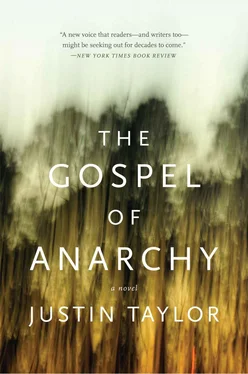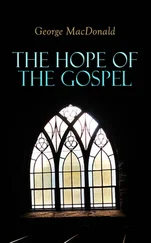Blessed are they that have not seen, and yet have believed . John 20:29. She knew she’d get it.
By the time she arrives at the Millhopper it’s four o’clock, and the park is only open till five. That’s okay. Since she’s not driving a car, she technically doesn’t have to pay the four-dollar entry fee, and the whole thing is honor system anyhow — there’s nobody watching — but this is one place she likes supporting, no matter that it’s government-run. She fishes around in her jeans pocket and comes up with two singles, a quarter, a dime, and, weirdly, a Canadian coin the exchange value of which she couldn’t so much as venture a guess about. Oh well. She pushes the whole mess through the slot cut into the top of the wooden box, then walks her bike over to the rack and secures it with her chain and a Master lock that she expropriated from the Walmart on Thirteenth Street. Have a nice $9.95 worth of economic sanction, you union-busting sweatshop-loving fucks.
She’s got the whole place to herself. Lucky! Though it’s not that surprising if you think about it. Summer Sunday like this, hot as hell and twice as muggy, though it’ll be cooler inside the sink, under all that tree cover, where a sweet breeze always blows. There’s this wooden staircase you walk down. At the very bottom there’s a viewing platform with some benches.
As per the informational placards, the Millhopper’s unique formation has resulted in something like a miniature rain forest. You can find plants in the sink that you’ll hardly see anywhere else around this part of Florida, which is mostly swamplands and plains. There are several small streams and tiny falls formed by rainwater. Home to a startling variety of insect life, and so on. Katy knows all this, and isn’t interested anyway. She’s not exactly a nature buff. What she likes about the Devil’s Millhopper is the fact that from the bottom, looking up, all you can see is a round patch of sky ringed by the tops of trees that rise fifty and seventy feet up from ground level. That plus the depth of the sink means almost two hundred feet between Katy on the viewing platform (once she gets there) and the treetop crown swaying up in the blue. It’s like she’s standing in the cradle of life, looking straight up at the eye of Heaven, or better yet, being looked down upon by It. Or both, actually. Why not?
She also likes the legend, the story of how it got its name. That’s on a placard, too; the one sign she always makes a point of reading when she visits though she’s long known the tale by heart. It goes like this: Once there was an Indian princess living here, and the Devil wanted to marry her, but she wouldn’t. So, being the Devil, he kidnapped her, and all the braves in her tribe went to go fight the Devil and get her back. As they were closing in on him, the Devil made the sinkhole for them to fall in, which they did, but it didn’t stop them, and they started to climb out, so the Devil turned them to stone so they couldn’t, which is why there’s so much water coming out of the rock faces inside the sink — it’s the endless weeping of the turned-to-stone braves, and they cry not for their own sad fate but for that of their princess.
The reason Katy likes this story isn’t obvious. In fact, she didn’t understand it herself for a long time. The Devil is the key element. At first it seems like a pretty cool Indian legend, and okay so what, but here’s the thing. The story assumes the existence of a classical Christian Devil, with the capacity for action in the world. But the Indians didn’t believe in any Devil, much less that one, and so you eventually realize that this isn’t an old Indian legend, it’s a white people’s legend about Indians. And if you extrapolate further, doesn’t it seem like the real “moral,” beyond the just-so story aspect of how the sinkhole formed, is that if the Indians had been Christians they might have been able to better resist the black magic of the Christian Devil, and therefore might have gotten their princess back and not been turned to stone?
Talk about your cultural imperialism; talk about plain old fucked-up. And yet. There’s something beautiful about it also, sort of running concurrently with the monstrosity. She can’t put her finger on it exactly, but it has to do with ideological miscegenation, how all cultures are just hodgepodges, collages, patch jobs. Try putting it this way: the monstrosity is the beauty.
Katy’s about halfway down the staircase, a series of steep flights linked by switchback landings. She’s paused on one of these, surveying all she sees before her: trying as always to really and truly open her eyes, heart, and spirit to this experience. Her self-articulated goal is to take everything in. She’s even breathing deeply, gulping swollen lungfuls of wet air and holding them until the wonderful burning in her chest lets her know she’s absorbed every last whisper of oxygen. May the air she releases be pure carbon dioxide; let it be as a blessing to the trees.
If you stuck the Statue of Liberty in the Devil’s Millhopper, only its torch would stick out. (That’s not counting the base, but still.) The vibe here is ancient and wild, soul-memory stirred in deep time. Primeval, if that’s not too cheesy to say — and shit, Katy thinks, if it is then so what? Look around. Positively Precambrian. It’s Edenic — no, no, scratch the adjective form; this is Eden. Everywhere she looks: life! Live oaks and longleaf pines. Berry bushes buzzing with attendant insects, countless ferns, plus a plenitude of lesser scrubs, shrubs, and grasses, all nameless — at least to Katy — but what do names matter? Everywhere they rise up from the soaked brown ground. Lichens blooming wintergreen-pale on trunks and branches. Arm-thick vines strung tree to tree like power lines. Who can say where they start or end? Who says they ever do? Water burbling through stream beds, or spinning free from fissured rock face into space, falling and then splashing down, sucked up with eager, greedless relish by the soil and porous lime. She’s not deep enough down yet to see the Indians’ tears but she can hear their burbling, can picture the vermilion mosses coating the wet black faces of stone. Spindly limbs hang low over the stair path; tiny spiders swing on threads of sticky silk so thin they’re invisible until they catch the light. And lizards on the topsides of those same branches, flashing fiery speckled dewlaps, ready to mate. Squirrels giving chase up and down trunks broad and gnarled and impossible with age, and the rodents’ chittering lost in the high chorus of a million cicadas, and this ceaseless noise pierced by bird squalls or some lone woodpecker’s sporadic tattoo.
Everything throbbing together, and all of it holy — each single thing, and the unity of all things, and the throb itself.
Katy rushes the rest of the way down the stair path. At the bottom, on the bench, she slings her backpack off, unzips it, scrambling for her journal and pen. Got to get this all down while it’s fresh. Before the ecstasy of God’s abundant grace — always present, always boundless, but only ever revealed in fragments, in glimpses — starts to fade. She’s flipping past unsent letters, poems in progress, sketches of Liz. It’s mere seconds till she arrives at the blank page, cracks the spine of the journal for luck, sets it down in her lap, uncaps the pen, and sets nib to paper, but she can already feel the revelation draining out of herself. Trying to focus her mind, trying to snatch shreds of it back, only makes it fade faster. Why does she keep doing this? There are things that exist beyond the limit of what can be described, captured, written, or even communicated. They can only be experienced, it seems, and all the mystics she’s ever read are in agreement on this one point. Does she really think she can succeed where Ibn Arabi, Isaac Luria, Aquinas, Crowley, and the anonymous monk who wrote Cloud of Unknowing all failed?
Читать дальше












